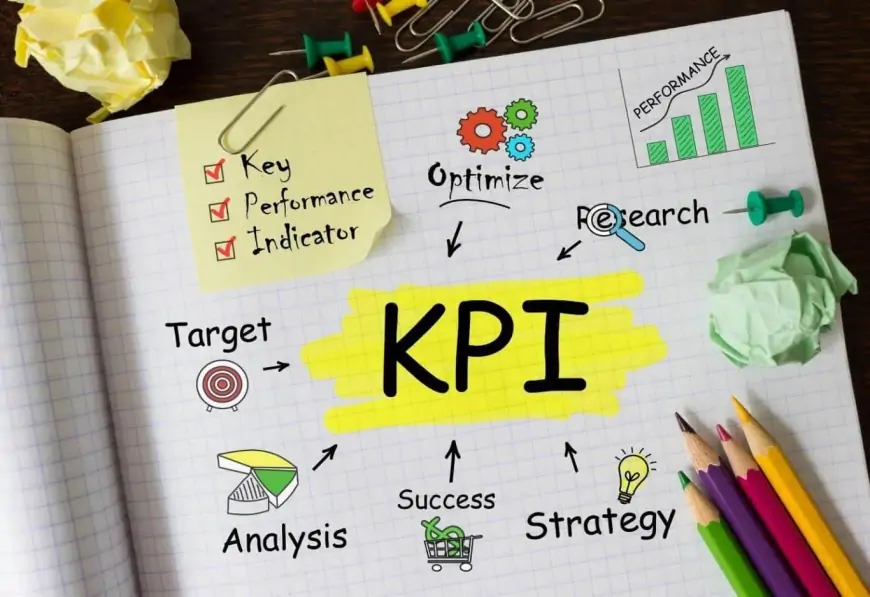What is a KPI? A beginner's guide
"A Key Performance Indicator (KPI) measures business performance against goals. It's crucial for tracking success and making informed decisions."

Businesses, regardless of size or industry, rely on Key Performance Indicators (KPIs) to track progress, optimize strategies, and enhance outcomes. Learn how to select, measure, and leverage KPIs effectively for informed decision-making and improved performance.
Understanding Key Performance Indicators (KPIs)
A Key Performance Indicator (KPI) serves as a measurable benchmark indicating the progress of individuals or businesses towards their goals. Assessing KPIs aids organizations in gauging their alignment with desired objectives. By examining various indicators encompassing areas like profits, sales figures, employee turnover, and average annual expenses, businesses can pinpoint successes and areas needing improvement. Regular analysis of KPIs offers a comprehensive view of business performance, empowering decision-makers to determine the continuation of current strategies or the necessity of strategic adjustments.
Distinguishing between KPIs and metrics
KPIs and metrics, although both measuring performance, differ in characteristics and business application. Metrics gauge progress broadly, while KPIs are specific to defined goals within a timeframe. KPIs align with business objectives, while metrics assess individual processes, often adhering to industry standards. Effective KPIs, typically numbering between five to seven, follow the "SMART" criteria: Specific, Measurable, Achievable, Relevant, and Time-bound, ensuring they drive progress and are pertinent to improving outcomes within set deadlines.
Best practices for KPIs
Selecting appropriate KPIs is crucial to avoid wasted time or adverse impacts on business outcomes. Ensure alignment with objectives; for instance, tracking customer wait time won't aid in reducing food waste in a donut shop. When choosing KPIs:
- Directly relate to objectives: Ensure KPIs are closely tied to business goals.
- Consider lagging vs. leading indicators: Balance past performance (lagging) with actions to achieve goals (leading).
- Set realistic, attainable measurements: Choose KPIs that are feasible and achievable.
- Opt for few, specific indicators: Focus on a select number of KPIs rather than overwhelming with too many metrics.
Frequently encountered KPI categories
KPIs are ubiquitous across various industries such as sales, marketing, customer service, IT, human resources, and finance. Choosing the right KPIs is crucial as they drive performance goals. Maintaining a manageable number of KPIs per goal facilitates effective assessments and keeps teams aligned. Here are some commonly used KPI examples:
Sales KPIs:
- Monthly sales growth
- Monthly customers per sales representative
- Quarterly sales bookings
- Number of engaged leads in sales funnel
- Average conversion time
Marketing KPIs:
- Monthly website traffic
- Page likes and comments
- Social media engagement rates
- Number of new monthly leads
- Click-through rate percentage
Customer service KPIs:
- Customer satisfaction score
- Customer retention rate
- Monthly support ticket submissions
- Average resolution time
- Cost per resolution
Human resources KPIs:
- Monthly overtime hours
- Quarterly training costs
- Cost per new hire
- Employee productivity
- Monthly absenteeism rate
Setting KPIs requires clear strategic goals as a starting point. Once objectives are defined, select appropriate analytical tools, often specialized software. Implementing KPIs allows for evaluation of their effectiveness; adjust as needed for better insights. KPIs should align with business objectives, be measurable, specific, and time-bound. Follow these steps:
- Determine key objectives: Align KPIs with organizational goals to ensure teams are focused.
- Define intended results: Specify desired outcomes to gauge success effectively.
- Utilize lagging and leading indicators: Lagging indicators reflect past performance (e.g., revenue), while leading indicators guide actions towards goals.
- Set targets and thresholds: Establish targets and thresholds to track progress and direction over time.
- Assess progress and readjust: Regularly review KPIs to identify areas needing adjustment and ensure alignment with evolving projects and objectives.
Advantages of KPIs
Using Key Performance Indicators (KPIs) offers several advantages, optimizing resource allocation and enhancing performance:
Real-time monitoring
KPIs enable ongoing monitoring of team performance, facilitating real-time adjustments and resource allocation for improved productivity.
Prevention of delays
By utilizing KPI frameworks, teams can swiftly assess task progress, identifying potential delays and making necessary adjustments to ensure timely completion of objectives.
Simplicity in formulation
KPIs are straightforward and easy to formulate, making them accessible to businesses of all sizes once their goals are defined.
Equity and transparency
KPIs foster transparency by sharing objectives, empowering employees, and ensuring clarity of responsibilities, thus fostering team investment and equity in success.
Bottom line
Regular KPI evaluations provide insights into achievements, issues, and trends, aiding informed decision-making and benefiting overall organizational health when appropriately selected and utilized.












































